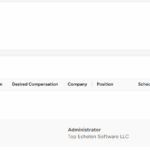In an era marked by globalization, technological advancements, and a growing emphasis on social responsibility, diversity and inclusion have become pivotal aspects of the contemporary job market. As professional recruiters and search consultants, it is crucial to recognize the challenges posed by the evolving landscape and proactively address them to foster a diverse and inclusive workplace.
In this blog post from Top Echelon Software, we will explore the multifaceted dimensions of diversity and inclusion in recruitment, examining challenges and proposing effective solutions.
Understanding the Landscape
Defining Diversity Beyond the Obvious
Diversity is often narrowly defined by gender and ethnicity, but it encompasses much more. It includes differences in age, sexual orientation, socio-economic background, physical and cognitive abilities, veteran status, and more. To effectively navigate this intricate landscape, recruiters must broaden their understanding of diversity and actively seek candidates with varied perspectives and experiences. Recognizing the full spectrum of diversity allows recruiters to create more inclusive workplaces that benefit from a wide range of viewpoints and skills.
- Age Diversity: Different generations bring unique perspectives and experiences to the workplace. Younger employees might be more tech-savvy, while older employees often have valuable institutional knowledge and experience.
- Sexual Orientation and Gender Identity: Ensuring that LGBTQ+ candidates feel welcomed and supported is crucial for fostering an inclusive environment.
- Socio-Economic Background: Candidates from diverse socio-economic backgrounds can bring different viewpoints and problem-solving approaches, contributing to innovation and creativity.
- Abilities and Disabilities: Inclusive hiring practices for individuals with disabilities can tap into a pool of talented candidates who are often overlooked.
- Veteran Status: Veterans bring discipline, leadership, and a unique set of skills acquired through military service.
Implicit Bias in Recruitment
Unconscious biases can significantly influence decision-making throughout the recruitment process. These biases may stem from cultural, social, or personal factors and can affect everything from resume screening to interview evaluations. Addressing implicit bias is crucial for fostering a fair and inclusive hiring process.
- Training and Awareness: Recruiters must undergo training to recognize and mitigate these biases. This training should be ongoing and cover various types of biases, such as affinity bias, confirmation bias, and halo/horns effect.
- Bias Mitigation Strategies: Implementing standardized processes, such as structured interviews and standardized evaluation criteria, can help reduce the impact of unconscious bias.
- Technology Solutions: Leveraging technology, such as AI-driven tools, can help identify and mitigate biases at various stages of recruitment.
Challenges in Recruitment
Pipeline Challenges
Building a diverse talent pipeline is a persistent challenge. Historically, certain demographics have been underrepresented in specific industries. To address this, recruiters need to engage in targeted outreach, collaborate with diverse professional networks, and establish partnerships with educational institutions to broaden the candidate pool.
- Targeted Outreach: Engage with community organizations, affinity groups, and professional networks that represent underrepresented demographics. Attend events and job fairs focused on diversity.
- Educational Partnerships: Establish partnerships with universities, especially Historically Black Colleges and Universities (HBCUs), women’s colleges, and institutions that serve a high percentage of minority students.
- Internship and Mentorship Programs: Develop internship and mentorship programs aimed at underrepresented groups to create a pipeline of future talent.
Inclusive Job Descriptions and Requirements
The language used in job descriptions can inadvertently discourage diverse candidates from applying. It is essential to use inclusive language, avoid unnecessary jargon, and focus on the skills and qualifications essential for the role. Additionally, recruiters should critically assess whether certain requirements are truly indispensable or if they inadvertently exclude qualified candidates.
- Inclusive Language: Avoid gender-coded language and phrases that may deter candidates from applying. For example, terms like “rockstar” or “ninja” may appeal to certain demographics while alienating others.
- Essential vs. Desirable Skills: Clearly distinguish between essential and desirable skills. Avoid creating unnecessarily long lists of qualifications that may discourage otherwise qualified candidates.
- Accessibility: Ensure that job descriptions are accessible to people with disabilities. Use plain language and provide alternative formats if needed.
The “Culture Fit” Dilemma
While cultural fit is essential, it should not be a euphemism for homogeneity. Encouraging a culture that values diverse perspectives and contributions is crucial. Recruiters should assess candidates based on their ability to enhance the existing culture rather than conform to it.
- Culture Add vs. Culture Fit: Shift the focus from “culture fit” to “culture add.” Look for candidates who can bring new ideas and perspectives to the organization.
- Inclusive Values: Clearly define and communicate the organization’s commitment to diversity and inclusion in its values and mission statement.
- Structured Assessments: Use structured assessments to evaluate how a candidate’s values and behaviors align with the organization’s inclusive culture.
Unconscious Bias in Interviews
Interviews are prone to unconscious bias. Standardizing interview processes, using structured interview questions, and involving diverse interview panels can help minimize bias. Additionally, providing interviewers with diversity and inclusion training ensures fair evaluations.
- Structured Interviews: Develop a set of standardized questions that are asked of all candidates. This ensures consistency and fairness in the evaluation process.
- Diverse Panels: Assemble diverse interview panels to provide multiple perspectives and reduce the impact of individual biases.
- Behavioral and Situational Questions: Use behavioral and situational questions to assess how candidates have handled real-world situations, focusing on their problem-solving and interpersonal skills.
Solutions and Best Practices
Implementing Blind Recruitment Practices
Blind recruitment involves removing personally identifiable information from resumes during the initial screening phase. This helps mitigate biases related to gender, ethnicity, and other factors, allowing recruiters to focus solely on a candidate’s skills and qualifications.
- Anonymous Applications: Implement systems that allow for anonymous applications, where names, genders, and other identifiers are removed.
- Skills-Based Assessments: Use skills-based assessments and work samples as part of the screening process to objectively evaluate candidates’ abilities.
- Technology Solutions: Leverage recruiting software that automates the removal of identifiable information from resumes and applications.
Technology as an Ally
Leverage technology to enhance the recruitment process. Applicant tracking systems (ATS) with built-in diversity analytics can help recruiters track and analyze the diversity of their candidate pool. AI-driven tools can aid in identifying and mitigating biases at various stages of recruitment.
- Diversity Analytics: Use ATS with diversity tracking capabilities to monitor the diversity of applicants at each stage of the recruitment process.
- AI Tools: Implement AI tools that can analyze job descriptions for biased language and suggest alternatives. AI can also help in screening candidates based on objective criteria.
- Virtual Reality (VR) Assessments: Consider using VR assessments to evaluate candidates’ skills in a simulated environment, reducing the influence of biases.
Diverse Interview Panels
Construct interview panels that reflect diversity within the organization. Diverse perspectives on the panel can help in evaluating candidates more comprehensively and can also send a positive message about the organization’s commitment to inclusivity.
- Panel Composition: Ensure that interview panels include members from different genders, ethnicities, and backgrounds.
- Training for Panel Members: Provide training for interview panel members on recognizing and mitigating bias during interviews.
- Feedback Mechanisms: Implement feedback mechanisms for panel members to share their observations and learn from each other’s perspectives.
Collaboration with Diverse Professional Networks
Building relationships with diverse professional networks, industry associations, and community organizations can provide access to a broader talent pool. Attend events, workshops, and conferences dedicated to diversity and inclusion to actively engage with potential candidates.
- Partnerships: Establish partnerships with organizations that focus on diversity, such as National Society of Black Engineers (NSBE) or Society of Women Engineers (SWE).
- Sponsorships: Sponsor and participate in diversity-focused events and conferences to raise the organization’s profile among diverse talent.
- Community Involvement: Engage with local community organizations that support underrepresented groups to build a strong presence and attract diverse candidates.
Employee Resource Groups (ERGs)
Establishing and supporting ERGs within the organization creates a sense of belonging for employees from various backgrounds. These groups can also serve as valuable resources for recruiting efforts, offering insights into the needs and expectations of diverse candidates.
- Support and Funding: Provide ERGs with the necessary support and funding to carry out their activities effectively.
- Involvement in Recruitment: Involve ERG members in the recruitment process to gain insights into how to attract and retain diverse talent.
- Mentorship Programs: Encourage ERGs to develop mentorship programs that connect new hires with experienced employees from similar backgrounds.
Training and Education
Regularly conduct diversity and inclusion training for all members of the recruitment team. This training should encompass the identification of biases, cultural competence, and effective communication strategies. Ongoing education ensures that the team remains attuned to the latest best practices.
- Comprehensive Training Programs: Develop comprehensive training programs that cover various aspects of diversity and inclusion, including unconscious bias, cultural competence, and inclusive language.
- Continuous Learning: Promote a culture of continuous learning by providing access to resources, webinars, and workshops on diversity and inclusion.
- Inclusive Leadership Training: Offer training for leaders on how to create and sustain an inclusive work environment.
Data-Driven Decision-Making
Utilize data analytics to measure the effectiveness of diversity initiatives. Regularly assess the diversity of the candidate pool, interviewees, and hires. Identify patterns and areas that need improvement, allowing for continuous refinement of recruitment strategies.
- Metrics and KPIs: Define key performance indicators (KPIs) related to diversity and inclusion, such as the diversity of applicants, interviewees, and hires.
- Regular Reporting: Implement regular reporting on diversity metrics to track progress and identify areas for improvement.
- Data-Driven Strategies: Use data to inform recruitment strategies, such as identifying sources that yield the most diverse candidates or highlighting stages in the recruitment process where diverse candidates drop off.
Embracing diversity and inclusion is not just a moral imperative; it is also a strategic advantage in today’s competitive job market. By understanding the challenges and adopting proactive solutions, professional recruiters and search consultants can play a pivotal role in shaping inclusive workplaces. From redefining diversity to implementing blind recruitment practices and leveraging technology, the journey toward a diverse and inclusive workforce requires a multifaceted approach. As advocates for talent acquisition, recruiters hold the power to drive positive change, shaping organizations that reflect the richness of human experience and potential.
By fostering a diverse and inclusive environment, recruiters and search consultants can help organizations tap into a wider talent pool, enhance innovation, and improve employee satisfaction and retention. The commitment to diversity and inclusion must be ongoing, with continuous efforts to refine and improve recruitment practices.
In doing so, recruiters can contribute to building workplaces that are not only more equitable but also more successful and resilient in the face of an ever-changing global landscape!









